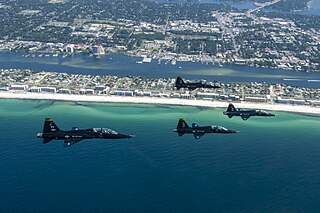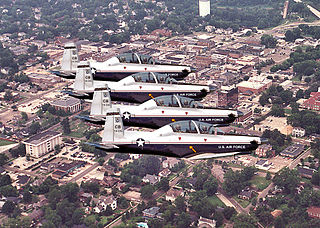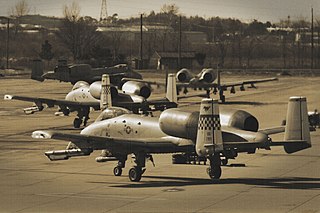
The 40th Flight Test Squadron is a United States Air Force unit. It is assigned to the 96th Operations Group, based at Eglin Air Force Base, Florida.

The 65th Aggressor Squadron is a United States Air Force unit currently operating the F-35A Lightning II. It is assigned to the 57th Operations Group at Nellis Air Force Base, Nevada.

The 414th Combat Training Squadron is a United States Air Force unit assigned to the 57th Wing, 57th Operations Group at Nellis Air Force Base, Nevada. The 414th is a non-flying organization charged with hosting Red Flag exercises, Air Combat Command's largest Large Force Exercise (LFE).

The United States Air Force's 347th Rescue Group is an active combat search and rescue unit assigned to the 23rd Wing at Moody Air Force Base, Georgia.

The 413th Flight Test Group is a United States Air Force Air Force Reserve Command unit. It is stationed at Robins Air Force Base, Georgia as a tenant unit.

The 2nd Fighter Training Squadron, sometimes written as 2d Fighter Training Squadron, is an active United States Air Force unit, assigned to the 325th Operations Group at Tyndall Air Force Base, Florida.

The 4th Fighter Squadron, "Fighting Fuujins" is part of the 388th Fighter Wing at Hill Air Force Base, Utah. It operates the Lockheed Martin F-35 Lightning II aircraft, which replaced the unit's General Dynamics F-16 Fighting Falcons in August 2017. The 4th FS primarily conducts air superiority, strike, and close air support missions.

The 54th Fighter Squadron is an inactive United States Air Force unit. Its last assignment was to the 3d Operations Group, being stationed at Elmendorf Air Force Base, Alaska. It was inactivated on 28 April 2000.

The 61st Fighter Squadron is an active United States Air Force unit, assigned to the 56th Operations Group, at Luke Air Force Base, Arizona. It operates the F-35 Lightning II aircraft, conducting Pilot training.

The 310th Fighter Squadron is part of the 56th Operations Group at Luke Air Force Base, Arizona. It operates the Lockheed Martin F-35A Lightning II, conducting advanced fighter training.

The 418th Test and Evaluation Squadron is an active United States Air Force unit assigned to the 53rd Test and Evaluation Group, and stationed at Davis-Monthan Air Force Base, Arizona, where it was activated on 1 October 2021.

The 5th Flying Training Squadron is part of the United States Air Force's Air Force Reserve Command serving as a reserve associate squadron operating with the 71st Flying Training Wing at Vance Air Force Base, Oklahoma. It operates the Raytheon T-1 Jayhawk, Northrop T-38C Talon, and Beechcraft T-6A Texan II aircraft conducting flight training in support of the 71st Operations Group.

The 25th Flying Training Squadron is part of the 71st Flying Training Wing based at Vance Air Force Base, Oklahoma. It operates Northrop T-38 Talon aircraft conducting flight training.

The 57th Weather Reconnaissance Squadron is an inactive United States Air Force squadron. Its last assignment was with the 9th Weather Reconnaissance Wing at Hickam Air Force Base, Hawaii, where it was inactivated on 10 November 1969.

The 337th Flight Test Squadron was most recently part of the 46th Test Wing and based at McClellan Air Force Base, California. It performed depot acceptance testing until being inactivated with the closure of McClellan on 13 July 2001.

The 445th Test Squadron is a United States Air Force squadron. It is assigned to the 412th Operations Group at Edwards Air Force Base, California. The 445th is part of the Air Force Test Center. Originally constituted in 1943 as the 445th Fighter Squadron, it was involved in the early testing of the first U.S. jets, the Bell P-59 Airacomet and later the Lockheed P-80 Shooting Star. The squadron would also be involved in flight-testing captured enemy aircraft, such as the Mitsubishi A6M Zero. During the Cold War, the unit served under the Air Defense Command as the 445th Fighter-Interceptor Squadron, flying various interceptor aircraft in defense of the Continental United States. Inactivated in 1968 following a draw-down of active duty interceptor units, it was reactivated as the 6512th Test Squadron Squadron in 1969, beginning its official flight-testing mission. The unit was inactivated, reactivated, and redesignated multiple times over its life, being most recently reactivated with its current name in 2022.

The 461st Flight Test Squadron is a United States Air Force squadron, assigned to the 412th Operations Group of Air Force Materiel Command, and is stationed at Edwards Air Force Base, California. The Squadron performs flight testing on the Lockheed Martin F-35 Lightning II.

The 29th Test and Evaluation Squadron is an active United States Air Force unit. It is assigned to the 753d Test and Evaluation Group, at Eglin Air Force Base, Florida.

The 14th Operations Group is the flying component of the 14th Flying Training Wing, assigned to the United States Air Force's Air Education and Training Command. The group is stationed at Columbus Air Force Base, Mississippi.

The 51st Operations Group is the operational flying component of the United States Air Force 51st Fighter Wing, stationed at Osan Air Base, South Korea.


























